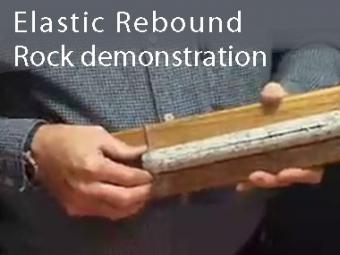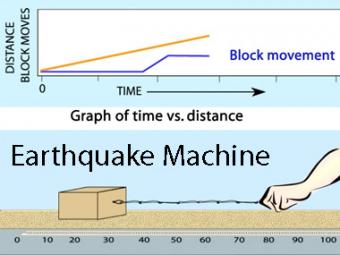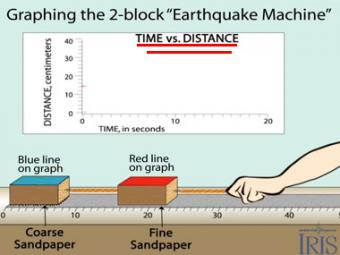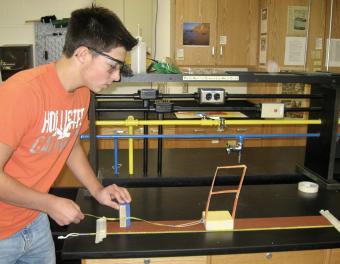How can I model earthquake slip-stick behavior in the classroom?
Describes parts needed to build the Earthquake Machine.
The simplicity of the Earthquake Machine allows students to visualize the inputs and outputs of a fault system and explore stick-slip fault behavior. The model’s wooden block, rubber band, measuring tape and sandpaper base all represent an active fault section. Your pull on the measuring tape and rubber band attached to the block is analogous to slow, continuous plate motions. For example, this might represent the downward pull of a subducting slab of lithospheric plate, which is continuously adding tension to the system. The rubber band represents the elastic properties of the surrounding rocks, storing potential energy as they are deformed (yes, rocks actually bend elastically!). The sandpaper represents the contact between the sides of the fault. When the frictional forces between the block and sandpaper are overcome, the block lurches forward, representing ground motion during an earthquake. The description of this entire process (that is, the slow accumulation of strain energy in elastic material, followed by the released in a sudden slip event) is known as elastic rebound theory.
Shopping list: Wood block, sanding belts, rubber bands, eye bolt and tools
Discovery

This demonstration shows that rocks are elastic by squeezing a slit core of rock.

THE two-block "Earthquake Machine" uses two blocks with different grit sandpaper to model interactions between adjacent patches along a fault.

Animation of the single-block "Earthquake Machine", a mechanical model of the earthquake process using a wood block, sandpaper, and rubber bands. This model shows how "Forces, Faults, and Friction" interact as elastic energy is slowly stored when the rubber back stretches and then is rapidly released as the block jerks during an "earthquake".

Graphing time vs. distance using the classic block-and-sandpaper "earthquake machine"

Graphing time vs. strain using the classic block-and-sandpaper "earthquake machine"

Using a block-and-sandpaper model, students collaborate in small groups to investigate how energy is stored elastically in rocks and released suddenly as an earthquake (the earthquake cycle). This activity emphasizes the role of mechanical models in understanding and testing ideas in science.

In this activity, students explore of the concept of probability and the distribution of earthquake sizes, and then work to understand how earthquake hazards are described by probabilities. Students then work in small groups to collect and analyze data from a simple physical earthquake model and use online data to investigate and compare the earthquake hazards in California and Missouri.